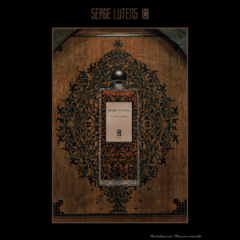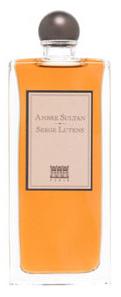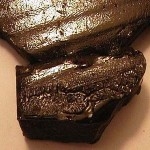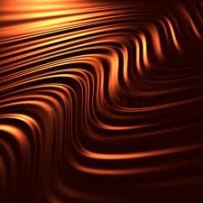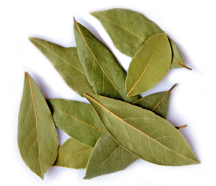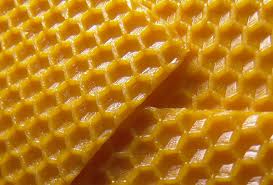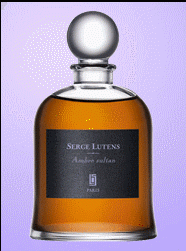Amber on steroids, if not the Incredible Hulk of ambers. That is O Hira, a stunning, super-powered, monster labdanum that would be worthy of its own character in the Marvel universe. O Hira is a simply spectacular extrait from Stéphane Humbert Lucas, and a scent which made me do an instant double-take the first time I smelt it. I actually said “ooohh!” and closed my eyes to better take in the tidal wave of richness. The molten, dripping, resinous juices were so beautifully honeyed, dark, leathery, and toffee’d, I was amazed. And, at a higher dosage, O Hira showed a naughty side that drove me quite wild. All I can say is, if I came across a man wearing O Hira, I’d want to rip his clothes off pretty quickly. I’m quite serious about that. I think O Hira on the right man or woman could be quite devastating.
O Hira is a 2013 parfum extrait released by the Paris niche house, Stéphane Humbert Lucas 777 (hereinafter just referred to as “SHL 777” or “777“). Monsieur Lucas used to be the in-house perfumer for SoOud and Nez à Nez, but he launched his new house in 2013. All the 777 fragrances are created by Monsieur Lucas himself. Up until now, the line was exclusive to Europe, Russia, and Middle Eastern, but there is excellent news. The complete SHL 777 line will be coming to America in a few weeks, including new releases like Qom Chilom which I covered yesterday, the smoke monster, Oud 777 (which includes tobacco and leather touches), the mandarin-ginger-immortelle-tobacco scent, Une Nuit à Doha, and the stunning Black Gemstone which is one of the best fragrances that I’ve tried this year. They will all be carried at Luckyscent and Osswald NYC. I have samples of the complete line, thanks to the graciousness and kindness of Monsieur Lucas, and I will be going through them, one by one (though perhaps with some breaks and perhaps not all in a row) so that you will be well prepared when 777 hits the stores.
O Hira is an ode to amber. SHL 777 has no official notes for the fragrance, and the press release photos or website descriptions only say:
No Pyramid.
Remake of fossilized Amber
Primitive Scent – Pure – Rare – Intense – Dedicated to the amber lovers.
I’ve had some correspondence with Monsieur Lucas, and he elaborated a little further. He spent more than two years working just on O Hira, using complicated, classical techniques of “distillerie, effeuillage, glacis” on the most expensive raw materials. The fragrance is an extrait with 24% concentration, and is intended to be the richest soliflore around. No, there is no actual fossilized amber, so if you’re imagining something dug up from the bowels of the earth and dating from prehistoric times, you’d be mistaken. However, it’s clear to me from the scent that Monsieur Lucas has worked very hard with not only labdanum but some other materials, including a few really dark resins, to create a scent that is as dark and as heavy as if it really had been dug up from the earth.
This review won’t be a traditional review in the way that they are usually structured because O Hira is ultimately a soliflore devoted to labdanum and, thus, its core aroma is quite simple in some ways. So, I want to start by taking a few minutes to talk specifically about labdanum. It has a very dark, toffee’d, nutty, resinous, balsamic aroma that can often feel very honeyed. It can also sometimes have a masculine, leathery undertone, which is why some amber lovers I know aren’t particularly enthused by its distinctive, almost “dirty” aroma. For me, the visuals with true labdanum are dark brown, verging almost on black, and far from ambered gold. That brings to me a very important point.
Some of my regular readers may have noted that, in my reviews, I often write “labdanum amber” or “labdanum,” instead of simply saying “amber.” It’s not because I am OCD, but because I think the difference is enormous. A perfumer once told me, “only labdanum is real amber.” Someone else said words to the effect of, “a lot of fragrances listed as ‘amber’ today aren’t actually amber, because they’re not centered on labdanum. The note is either synthetic, or an approximation of amber through other means, like an accord using labdanum highly diluted with vanilla and benzoins to really become something else.”
Labdanum amber has a dark, dirty scent that is quite unique from many of the “ambers” listed even in the niche world, and it’s also completely different from ambergris. If you’re familiar with Dior‘s Mitzah, the opening of Serge Lutens‘ Ambre Sultan (minus the herbal nuances), parts of Tom Ford‘s Amber Absolute or Sahara Noir, and the more goaty, masculine, almost dirty parts of Amouage‘s Opus VI (separate from the Ambranum and Z11), then you’ve encountered labdanum. However, if you’ve tried Dior‘s Ambre Nuit or Profumum Roma‘s Ambra Aurea, then you’ve really experienced ambergris for the most part. And if you’re thinking about softer, gentler, or powdered ambers like Histoires de Parfums‘ Ambre 114, then you’re talking about the quasi-amber made up primarily of benzoins for an approximation of a golden amber. But it’s most definitely not labdanum amber, in my opinion.
O Hira opens on my skin with a tsunami of true, undiluted, super concentrated labdanum in all of its manifestations. It is heavily honeyed, almost boozy at times, completely brown and dirty, with a hefty, walloping amount of cinnamon mixed in. Within seconds, it turns smoky with what is clearly styrax, the darkest and most leathered of all resins (and a big base note in such fragrances like Guerlain’s Habit Rouge). I suspect there is also a massive dose of Tolu balsam (as there is in Shalimar and Opium’s base) mixed in as well. What I’m less certain about are the tobacco tonalities that grow increasingly noticeable as the minutes pass. Is there actual tobacco absolute in O Hira, or is it a subset of the very dirty labdanum amber? How much of the leathery undertones come from the styrax, as opposed to something else?
It’s really hard to know the extent to which some of the nuances in O Hira stem from labdanum’s natural characteristics — only amplified and teased out to show their individual character — or whether they are from other supplemental sources as well. Monsieur Lucas told me that there is styrax in O Hira, and he mentioned cinnamon aromas from benzoins as well, so it’s very clear that O Hira is not just labdanum. But where the labdanum ends and the other notes begin is hard to say, because this is one superbly blended fragrance.
Within minutes, new layers emerge. I wouldn’t be surprised if there were some castoreum in O Hira because there is an absolute beautiful, velvety, very musky richness which appears. It is leathered, sharp, almost skanky, but also plush like velvet. The tobacco-like dirtiness also grows stronger, while the cinnamon fades. There is almost an incense-like whiff at the edges, though it probably stems from the styrax. Lurking deep, deep in the case, there is a subtle gingerbread note that smells like Siam benzoin as well.
For the most part, however, I would say that O Hira is a bouquet centered around MASSIVE amounts of labdanum, along with some styrax, tolu balsam, and a tiny touch of castoreum. I cannot begin to tell you the richness of the scent. When I applied several good, hefty sprays from my decant, I was overcome by memories of my beloved (vintage) Opium‘s base. At high doses, O Hira has the same walloping, sticky, dense, dripping viscosity as 1980s-version Opium (especially in the parfum concentration). It feels like the thickest sludge of darkened, smoky, treacly amber — and I use the word “sludge” as the highest compliment in this case.
At the same time, though, O Hira takes labdanum’s masculine, sometimes dirty underpinnings and heightens them to an extreme degree. For the first time since I reviewed Amouage’s Opus VI, I was transported back thousands of years to ancient times when shepherds would scrape the resin off the chests and beards of goats who had clambered on or around the rock rose. There is almost a sweaty, goaty quality to the labdanum, and it has a muskiness that feels almost animalic in the first hour. Interestingly, though, I didn’t detect anything similar when I applied only a small amount of O Hira. As I’m going to explain later in more detail, this is a fragrance that I think best shows off its nuances when you apply a lot of it. A few small sprays result in a scent that is much softer, less dense, less leathered, less dirty, and more cinnamon-like in aroma.
For me, O Hira is unlike the other rich ambers on the market. It’s extremely different from Ambra Aurea which is a primarily an ambergris soliflore, though O Hira does have the same very opaque, dense, concentrated richness. O Hira isn’t like Tom Ford’s Amber Absolute or Sahara Noir, either, because both of those scents are heavily infused with incense. If you took Amber Absolute’s core (without the frankincense), combined it with a stripped down version of Dior’s Mitzah (without that fragrance’s supporting players), injected the two with vintage Opium’s resinous base, boiled the whole thing down to its most reduced, sticky, balsamic form, and then injected it with steroids, you would get O Hira. It is such a fatty, over-the-top, super-saturated, dark, monster amber that it feels indulgent enough for someone like Henry VIII.
And it’s so damn sexy. When I applied a lot of it, the castoreum in the base exuded a muskiness that was not only very leathered, but also rather brazen and verging on the skanky. There was a seductiveness that once again called to mind vintage Opium’s base with its lusty, bold, take-no-prisoners, raw sensuality. I just wanted to slather O Hira on someone’s neck, lick it off, and then rip off their clothes. I mean it, O Hira got me quite hot and bothered at times.
The scent only becomes better as the minutes pass. The tobacco and leather tonalities are joined by something almost verging on dark chocolate, followed by a definite flicker of salty, black licorice after about 20 minutes. The whole thing feels so dark, it verges on the brown-black in hue, and is incredibly far removed from the golden palette of many “ambers” that I’ve tried. It also feels very masculine, though women who love dark, dirty, smoky, heavy, balsamic orientals should adore it as well.
As a soliflore, O Hira doesn’t change in its core bouquet or essence — but then it’s not meant to. O Hira seeks to focus on one central note, shown in all its facets; one very simple thing heightened to its most luxurious depths. However, it’s clear to me that a lot of different parts were melded and fused together to create this seemingly monolithic, dense, heavy, “amber” aria. This is the sort of fragrance that sings at operatic levels, like a Middle Eastern Valkyrie belting out her final passion on a funeral pyre. You know how I’m always going on about wanting my fragrances to be Wagnerian in nature? Well, this is it. O Hira is definitely The Ride of the Valkyries.

Artist: Helen Abbas, Mosaic Collection, Summer 2013, “(Erdowaz) Slate.” Source: IslamicArtMagazine.com. (Website link embedded within photo.)
Even if O Hira’s main note is unwavering labdanum, its nuances and layers most certainly change. After 30 minutes, the sometimes intense smokiness from the styrax pipes down a few notches. Or, perhaps, it merely infused every one of the other notes in such a way that it seems softer. At the same time, the honey and cinnamon tonalities take a step back, while the musky, toffee’d leather and tobacco undertones take a few giant leaps forward. O Hira also turns fractionally softer and airier in feel. On occasion, the perfume feels smoother, as if some of the edges had been buffed out. At other times, however, O Hira continues to feel like an intentionally raw, almost brute-strength amber. It’s merely dialed down from a 10 on the Richter scale to a 9. The drop is slightly bigger for O Hira’s density, however, moving from a solid 10 in the opening minutes to about a 7 after 40 minutes.
O Hira is massively potent at the start with very big sillage. I will try to give you a sense of things, but it will be hard to use my usual numbers for application or quantity. The decant I was sent had a slightly wonky spraying mechanism which wasn’t very smooth when pressed down and only gave out half-squirts, rather than a more usual, fluid spritz. Using 5 half-spritzes or roughly the equivalent of 2 big sprays from an actual bottle, O Hira projected out a good 5 inches at first, before it softened at the end of an hour to about 2 inches above the skin.
When I used a lesser amount — similar to one and a half very large sprays from a proper bottle or 3 wonky spritzes from my atomizer — things were slightly different. The projection dropped a little, and O Hira wafted out only about 2-3 inches at the start, though that is still quite good. The more noticeable difference, however, pertained to the notes. At the lower dose, O Hira became a much softer, less sticky scent with a slightly different set of nuances. It was slightly cleaner, less dirty in feel, with little of the castoreum muskiness, and none of the more brute, goaty undertones to the labdanum. The cinnamon was stronger; the styrax’s smokiness was much softer; there was much less tobacco in the undertones; no licorice nuance; and the more viscous, sticky, dense resemblances to Opium’s base largely vanished. To try to explain it in terms of visuals, O Hira felt less solidly brown-black, and more bronze-gold.

part of “The Blooming Tree,” Painting by Osnat Tzadok, via osnatfineart.com
http://www.osnatfineart.com/art/landscape-paintings/6088-The-Blooming-Tree.jsp
O Hira shifts over time in terms of its nuances and the prominence of its individual layers. However, it’s hard to give a clear description of what happens because each time I’ve worn the perfume, the layers are different at different times. The notes also feel a bit circular, in that they come back around just when you think they had died or retreated to the sidelines. For example, in one test, the tobacco seemed to fade away about 2.5 hours into O Hira’s development, though the leather remained, and the cinnamon from one of the benzoins grew much stronger. O Hira was softer, smoother, and had almost a creamy feel to it which was unexpected. O Hira lost a lot of its stickiness and opaque density, became airier, felt sheerer, and hugged the skin much more. However, it was still extremely potent when smelled up close.
That was one occasion, but, on another, the tobacco and leathered smokiness were still subtly blasting away well into the start of the 7th hour. In fact, much of O Hira’s progression of notes was different, starting with labdanum that felt practically boozy at the start, and which then transitioned into heavy cinnamon-labdanum, before ending up as darkly leathered, tobacco’d, toffee labdanum. In short, the order of the perfume pyramid was up-ended.
There are only two consistent aspects to O Hira. First, its primary bouquet from start to finish is some manifestation of dark labdanum — in all its various, complex nuances — with resins. Second, O Hira consistently lasts over 11 hours. With a lesser quantity, O Hira’s longevity clocks in at about 11.5 hours. With a higher dosage (the equivalent of 2 sprays from an actual bottle, or much more), O Hira has lasted up to 14.5 hours on my perfume consuming skin. The sillage is always monstrous at first, but it generally drops to about 1-2 inches above the skin which is where it stays for hours and hours. On average, O Hira turned into a complete, true skin scent on me about 7 hours in with a large quantity, and 5.75 hours into its development with a small amount.
In a way, the best way to sum up O Hira is in terms of the images or moods that it evokes. Depending on which one of the notes dominates on your skin, O Hira can either be lavishly rich and indulgent, in an opulent manner worthy of Henry VIII, or positively sensual, brazenly seductive, darkly raw, brutal, and oozing pure, animal sex appeal. It’s a surfeit of riches, either way, and honestly feels like amber on steroids. I think it’s the Incredible Hulk of ambers, but I’ve been mulling over the possibility that it may be Iron Man instead.
The reason is that there is a definite refined intelligence to how O Hira’s notes have been put together, an attempt to have some sense of luxurious refinement that goes beyond mere brute strength or primal rawness. Speaking purely for myself, I think Tom Ford’s ambers verge more into the brute force category, and have some synthetics that prevent the scents from feeling quite as pure. To me, his ambers are potent and rich, but they don’t evoke luxurious opulence and refinement in quite the same way. They also don’t smell as if the most expensive raw ingredients have been used in almost undiluted form, which is the sense I get with O Hira. In short, O Hira feels much more sophisticated, expensive and nuanced. To me, it has class. It feels like a European’s baroque, almost Gaudi-esque interpretation of “death by amber.”
O Hira may have been released in 2013, but I couldn’t find any reviews of the scent to provide you with a comparative assessment. O Hira doesn’t even have an entry on Fragrantica at this time. In fact, at the time of this post, it’s not widely available outside of Harrods and Paris’ Printemps. That will change in 2-3 days time when, I’ve been told, Germany’s First in Fragrance should receive O Hira, along with several of the new 2014 fragrances. As noted at the start of this post, the complete SHL 777 line will be released in the U.S. in roughly 2 weeks time.
The bad news in all this is that O Hira is very expensive. I mean, seriously expensive. I don’t have the official American pricing information but, in Europe, O Hira’s retail price is a hefty €580 for a 50 ml bottle of pure parfum. I have heard rumours and talk that O Hira will cost $795 in the U.S., but none of that has been confirmed. The bottom line is that O Hira is going to cost you a lot, regardless of the currency that you use. It is certainly too rich for my blood. As a general rule, and regardless of the brand, I have difficulty with nosebleed prices like these — but I find it even harder when it comes to something that is a soliflore.
O Hira’s quality and luxuriousness, though, make the math much more difficult and complicated. There is absolutely no question in my mind that the most expensive ingredients have been used in O Hira, that great care was taken with complicated techniques, and that none of it came cheaply. I can fully understand why it took more than 2 years to finesse raw materials used in such intense quantities, so that the end result would be something nuanced and so spectacularly rich. I can see it, I can smell it, and I have no doubts at all. But it’s still too expensive, in my opinion.
At the end of the day, however, it all comes down to what I’ve now decided to call the “Roja Dove Rule“: it’s going to be a personal calculation that comes down to each individual’s subjective valuation and tastes — and the extent to which the fragrance in question brings them to their knees such that the price becomes worth it to them.
All I can say is that O Hira is absolutely worth sampling and, if possible, getting in a decant. It’s the bloody Incredible Hulk of Ambers. I think that it’s in a class all of its own.
Disclosure: Perfume sample courtesy of Stéphane Humbert Lucas. That did not influence this review. I do not do paid reviews, and my opinions are my own.













